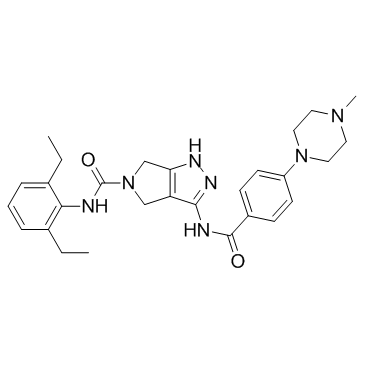398493-79-3
| Name | N-(2,6-diethylphenyl)-3-[[4-(4-methylpiperazin-1-yl)benzoyl]amino]-4,6-dihydro-1H-pyrrolo[3,4-c]pyrazole-5-carboxamide |
|---|---|
| Synonyms |
N-(2,6-diethylphenyl)-3-{[4-(4-methylpiperazin-1-yl)benzoyl]amino}-2,6-dihydropyrrolo[3,4-c]pyrazole-5(4H)-carboxamide
N-(2,6-Diethylphenyl)-3-{[4-(4-methyl-1-piperazinyl)benzoyl]amino}-4,6-dihydropyrrolo[3,4-c]pyrazole-5(1H)-carboxamide N-(2,6-Diethylphenyl)-4,6-dihydro-3-[[4-(4-methyl-1-piperazinyl)benzoyl]amino]pyrrolo[3,4-c]pyrazole-5(1H)-carboxamide N-(2,6-diethylphenyl)-3-(4-(4-methylpiperazin-1-yl)benzoylamino)-4,6-dihydro-1H-pyrrolo(3,4-c)pyrazole-5-carboxamide S1454_Selleck cc-476 PHA-680632 |
| Description | PHA-680632 is an aurora kinase inhibitor with IC50s of 27, 135 and 120 nM for aurora A, B and C, respectively. |
|---|---|
| Related Catalog | |
| Target |
Aurora A:27 nM (IC50) Aurora B:135 nM (IC50) Aurora C:120 nM (IC50) |
| In Vitro | PHA-680632 shows 30- to 200-fold higher IC50s of FLT3, LCK, PLK1, STLK2, VEGFR2, and VEGFR3 compared with Aurora A. PHA-680632 has potent antiproliferative activity in a wide range of cell types. The IC50s are 0.32, 0.41, 0.06, 1.17, 0.56, 0.62, 0.29, 0.11, 1.56, 0.62, 0.07, 0.13, 0.41 μM for C33A, HeLa, HCT116, HT29, LOVO, A549, MCF7, A2780, U2OS, DU145, U937, HL60, NHDF. PHA-680632 can cause polyploidy in tumor cells. PHA-680632 cell treatment induces phenotypes similar to Aurora A or B depletion[1]. PHA680632, inhibits colony formation in different cancer cell lines and induced polyploidy. Aurora-A inhibition by PHA680632 enhances radiation response in cancer cells, especially in p53-deficient cells[2]. |
| In Vivo | PHA-680632 suppresses tumor growth in animal models. PHA-680632 treatment at 45 mg/kg dose results in 85% of TGI without signs of toxicity in the HL60 human acute myelogenous leukemia xenograft model. PHA-680632 treatment at 60 mg/kg i.v. b.i.d. for 5 days results in 78% of TGI without signs of toxicity in the A2780 human ovarian carcinoma model[1]. PHA680632 in association with radiation leads to an additive effect in cancer cells, especially in the p53-deficient cells, but does not act as a radiosensitiser[2]. |
| Kinase Assay | Inhibition of kinase activity by PHA-680632 is assessed using a scintillation proximity assay format. In this assay, the biotinylated substrate is transphosphorylated by the kinase in presence of ATP traced with γ33-ATP. The phosphorylated substrate is then captured using streptavidin-coated scintillation proximity assay beads and the extent of phosphorylation is evaluated by β-counter after a 4-hour rest for the floatation of the beads on a dense 5 M CsCl solution. In particular a peptide derived from the Chocktide sequence (LRRWSLGL) is used as substrate for Aurora A, whereas the optimized peptide Auroratide1 is employed for Aurora B and C. The assay is run in a robotized format on 96-well plates. The potency of the compound toward Aurora kinases and 29 additional kinases belonging to our Kinase Selectivity Screening panel is evaluated and the relevant IC50s are determined[1]. |
| Cell Assay | Cells are seeded at different densities ranging from 5,000 to 15,000 cm2 in 24-well plate with the appropriate complete medium. After 24 hours, plates are treated with PHA-680632 and incubated for 72 hours at 37°C in 5% CO2 atmosphere. At the end of incubation time, cells are detached from each plate and counted using a cell counter. IC50s are calculated using percentage of growth versus untreated control[1]. |
| Animal Admin | Mice: Tumour xenograft mice are randomly allocated into four groups (six mice per group): A, control; B, IR alone, 8 Gy in 1 day; C, PHA-680632 alone, 40 mg/kg, b.i.d., for 4 days; D, same dose of PHA-680632 combined with IR (24 h after the first administration of PHA680632, similar schedule as IR alone) for 4 days. Drug or vehicle control (same volume of 20% Tween-80 in 5% glucose solution) is administered intraperitoneally (i.p.). The tumour size is measured twice a week using an electronic caliper. Follow-up of individual mice is conducted. The tumour volume is estimated from 2D tumour measurements[2]. |
| References |
| Density | 1.3±0.1 g/cm3 |
|---|---|
| Boiling Point | 709.0±60.0 °C at 760 mmHg |
| Molecular Formula | C28H35N7O2 |
| Molecular Weight | 501.623 |
| Flash Point | 382.6±32.9 °C |
| Exact Mass | 501.285217 |
| PSA | 96.60000 |
| LogP | 3.04 |
| Vapour Pressure | 0.0±2.3 mmHg at 25°C |
| Index of Refraction | 1.676 |
| Storage condition | -20℃ |
